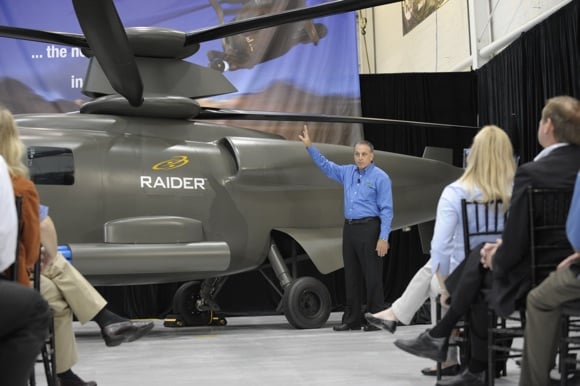Original URL: https://www.theregister.com/2010/10/21/sikorsky_x2_raider_plan/
X2 triplex super-copter to be offered as Army 'Raider' craft
Actively damp chopper - a soldier's dream?
Posted in Science, 21st October 2010 11:25 GMT
US whirlycraft firm Sikorsky, having successfully flown its revolutionary (cough) X2 triplex sprint-chopper to an impressive 250 knots, says that it will now look to put the same technology into a prototype armed scouting craft aimed at the US Army. However, the company seems keen not to spend too much more of its own cash on the effort without some concrete sign of interest from the customer.

I'm tellin' ya, ladies and gents - this thing goes like greased weasel shit
“Having proved the X2 Technology design to ourselves, we have full confidence we can now mature the technology for the US Army’s light armed reconnaissance helicopter,” said Sikorsky President Jeffrey Pino at a briefing yesterday. “Self-funding the design of a brand new light tactical helicopter – the Sikorsky S-97 – and manufacturing two prototypes we have designated as the Raider™ X2 helicopter will help military aviation evaluate the viability of a fast and maneuverable next generation rotorcraft for a variety of combat missions.”
It seems, however, that Sikorsky execs are hoping that the firm won't really have to self-fund the whole process of making the two Raider military demo craft - as it did with the original X2 proof-of-concept machine. Sikorsky adds that the next thing to happen will be a preliminary design review in 2011 and that "first flight, projected in four years, could depend in part on the pace of development and customer need".
The existing X2 reached its design speed of 250 knots in tests last month (see the vid on the next page) comfortably beating even the fastest normal chopper* and more than doubling the top speeds of most. Normal helicopters' speed is sharply limited by the fact that the tips of the forward-going rotor blades go supersonic as the aircraft speeds up. Their speed is also limited by the fact that backward-going blades will become stationary with respect to the air they cleave and so stop producing lift on one side of the craft.
The X2 avoids this by having two stacked contra-rotating sets of rotors, so that there are blades going forwards on both sides at any given time. The issue of supersonic blade tips is dealt with by slowing down the rotors' spin as speed increases, a thing that ordinary choppers can't do. The X2 shoves itself forward to higher speeds by the use of a pusher tail prop.
It worked this time 'cos it has stiffness and dampness
As the tail prop runs off the same drive as the main rotors, it too will slow its spin as the X2 speeds up, but it delivers more thrust by increasing the angle at which its blades cut the air. Thus as an X2-type craft accelerates towards maximum speed, all its blades will actually be slowing right down.
A somewhat similar effort to produce a high-speed stacked rotor chopper was attempted decades ago in the form of the XH-59A experimental craft. But the XH-59A suffered from severe, damaging vibration at high speeds and the idea never caught on. Today's X2 boasts modern superstiff rotors and active vibro-damping gear, and Sikorsky says that it can go at 250 knots while shuddering no more than a regular copter at top speed. Another big score for the X2 over the XH-59A is that all three of its eggbeaters run off a single turbine, where the earlier effort required no less than four engines (two for the rotors and two for thrust). Engine hours are one of the main factors in helicopter maintenance and running costs, so craft developed from the X2 should be considerably cheaper to buy and run.
Not many military aircraft are single-engined, of course, but there are a few: for instance the US Army's veteran Kiowa Warriors, used in roles collectively described as "armed scout". The Kiowa can spot targets for more heavily-armed Apache attack choppers or other aircraft, or attack them itself using Hellfire missiles, Hydra rockets or a variety of guns (it can also carry Stinger missiles for defending itself against enemy aircraft). Unlike an Apache it can instead carry a handful of passengers or other small payloads about.
The US Army really ought to replace its Kiowas soon, and the X2 "Raider" would seem an ideal candidate: it too could carry light armament or small numbers of personnel. Not that many helicopter roles genuinely call for doubling of speed, but presumably military scouting is one area where the X2's legs would be really useful. The only other VTOL aircraft with high speed right now is the famous V-22 Osprey tiltrotor, but this is twin-engined and has various disadvantages including severe downblast and a propensity to melt its landing pad. (Though the Osprey is somewhat faster at 270 knots top end.)
So Sikorsky ought to be onto a winner here with its Raider. But the US Army, like others around the world, is looking down the barrel of spending cuts in the near future: and helicopter "armed scouting" is scarcely the most treasured of its many missions and types of kit. Certainly the service has been happy enough to let Sikorsky make all the running so far, coughing up nothing to help with the development of the X2 to date.
Whirlybird watchers may be waiting a good bit more than four years for the Raider's first flight. ®
*The famous G-LYNX, a specially pimped Westland Lynx, still holds the ordinary-helicopter speed record at just over 216 knots (249 mph/401 km/h).